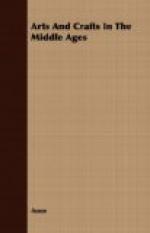The dangers of a clear gold ground were, felt more fully by the workers at Ravenna and Rome, than in Venice. Architectural schemes were introduced to break up the surface: clouds and backgrounds, fields of flowers, and trees, and such devices, were used to prevent the monotony of the unbroken glint. But in Venice the decorators were brave; their faith in their material was unbounded, and they not only frankly laid gold in enormous masses on flat wall and cupola, but they even moulded the edges and archivolts without separate ribs or strips to relieve them; the gold is carried all over the edges, which are rounded into curves to receive the mosaic, so that the effect is that of the entire upper part of the church having been pressed into shape out of solid gold. The lights on these rounded edges are incomparably rich.
It is equally important to vary the plain values of the colour, and this was accomplished by means of dilution and contrast in tints instead of by unevenness of surface, although in many of the most satisfactory mosaics, both means have been employed. Plain tints in mosaic can be relieved in a most delightful way by the introduction of little separate cubes of unrelated colour, and the artist who best understands this use of mass and dot is the best maker of mosaic. The actual craft of construction is similar everywhere, but the use of what we may regard as the pigment has possibilities similar to the colours of a painter. The manipulation being of necessity slow, it is more difficult to convey the idea of spontaneity in design than it is in a fresco painting.
To follow briefly the history of mosaic as used in the Dark Ages, the Middle Ages, and the period of the Renaissance, it is interesting to note that by the fourth century mosaic was the principal decoration in ecclesiastical buildings. Contantine employed this art very extensively. Of his period, however, few examples remain. The most notable is the little church of Sta. Constanza, the vaults of which are ornamented in this way, with a fine running pattern of vines, interspersed with figures on a small scale. The Libel Pontificalis tells how Constantine built the Basilica of St. Agnese at the request of his daughter, and also a baptistery in the same place, where Constance was baptized, by Bishop Sylvester.
Among the most interesting early mosaics is the apse of the Church of St. Pudentiana in Rome. Barbet de Jouy, who has written extensively on this mosaic, considers it to be an eighth century achievement. But a later archaeologist, M. Rossi, believes it to have been made in the fourth century, in which theory he is upheld by M. Vitet. The design is that of a company of saints gathered about the Throne on which God the Father sits to pass judgment. In certain restorations and alterations made in 1588 two of these figures were cut away, and the lower halves of those remaining were also removed, so that the figures are now only half length. The faces and figures are drawn in a very striking manner, being realistic and full of graceful action, very different from the mosaics of a later period, which were dominated by Byzantine tradition.




